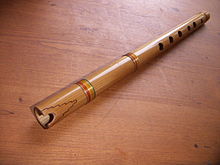Quena
Quena ( Hispanicized from Quechua / Aymara qina ), also called Andean flute , is a South American notch flute made of wood or bamboo and is particularly popular in the Andean music of Peru and Bolivia .
description
The quena is an edge-blown notched flute, so it does not have a separate mouthpiece, but a notch cut out on the straight edge. While with the recorder the air jet is channeled in order to hit the gap (labium) and produce the sound, with the quena one has to shape the lips in order to direct the air flow against the sharp edge.
Originally the quena was played with three or five holes in major scales; today it usually has seven holes. By fork handles or by half covering the holes it is also chromatically playable.
The approach (how the lips are set to produce a sound) of the quena can be found in numerous end-edge flutes, such as the Japanese shakuhachi .
Hardly any wind instrument that offers such technical possibilities as chromatics, differentiated dynamics, three octaves range, even tone color modulation, is as inexpensive as a quena. In Peru and Bolivia it costs between 50 cents (made of bamboo or plastic) and 80 euros (highly developed models made of hard wood, some with a mouthpiece made of bone).
literature
- Luis De La Calle: The Quena and the Siku. A comparison between Bolivian and Peruvian playing techniques. Musikhögskolan i Malmö, Lunds universitet, 2008, pp. 1–39
Web links
- The Quena (MP3; 770 kB)
